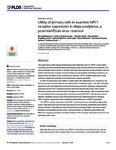Utility of primary cells to examine NPC1 receptor expression in Mops condylurus, a potential Ebola virus reservoir
Bokelmann, Marcel
Edenborough, Kathryn
Hetzelt, Nicole
Kreher, Petra
Lander, Angelika
Nitsche, Andreas
Vogel, Uwe
Feldmann, Heinz
Couacy-Hymann, Emmanuel
Kurth, Andreas
The significance of the integral membrane protein Niemann-Pick C1 (NPC1) in the ebolavirus entry process has been determined using various cell lines derived from humans, non-human primates and fruit bats. Fruit bats have long been purported as the potential reservoir host for ebolaviruses, however several studies provide evidence that Mops condylurus, an insectivorous microbat, is also an ebolavirus reservoir. NPC1 receptor expression in the context of ebolavirus replication in microbat cells remains unstudied.
In order to study Ebola virus (EBOV) cellular entry and replication in M. condylurus, we derived primary and immortalized cell cultures from 12 different organs. The NPC1 receptor expression was characterized by confocal microscopy and flow cytometry comparing the expression levels of M. condylurus primary and immortalized cells, HeLa cells, human embryonic kidney cells and cells from a European microbat species. EBOV replication kinetics was studied for four representative cell cultures using qRT-PCR. The aim was to elucidate the suitability of primary and immortalized cells from different tissues for studying NPC1 receptor expression levels and their potential influence on EBOV replication.
The NPC1 receptor expression level in M. condylurus primary cells differed depending on the organ they were derived from and was for most cell types significantly lower than in human cell lines. Immortalized cells showed for most cell types higher expression levels than their corresponding primary cells. Concluding from our infection experiments with EBOV we suggest a potential correlation between NPC1 receptor expression level and virus replication rate in vitro.
Files in this item

